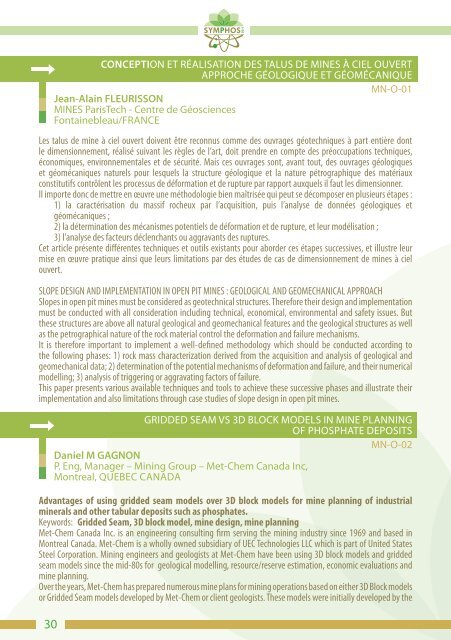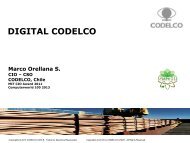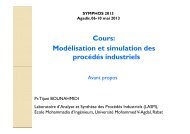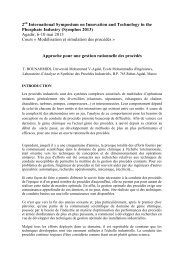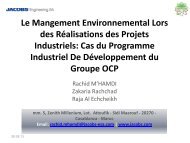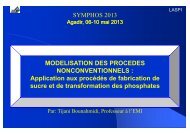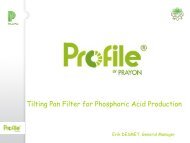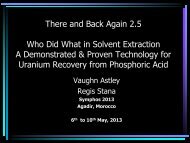Abstract SYMPHOS 2011
Abstract SYMPHOS 2011
Abstract SYMPHOS 2011
Create successful ePaper yourself
Turn your PDF publications into a flip-book with our unique Google optimized e-Paper software.
30<br />
CONCEPTION ET RÉALISATION DES TALUS DE MINES À CIEL OUVERT<br />
APPROCHE GÉOLOGIQUE ET GÉOMÉCANIQUE<br />
MN-O-01<br />
Jean-Alain FLEURISSON<br />
MINES ParisTech - Centre de Géosciences<br />
Fontainebleau/FRANCE<br />
Les talus de mine à ciel ouvert doivent être reconnus comme des ouvrages géotechniques à part entière dont<br />
le dimensionnement, réalisé suivant les règles de l’art, doit prendre en compte des préoccupations techniques,<br />
économiques, environnementales et de sécurité. Mais ces ouvrages sont, avant tout, des ouvrages géologiques<br />
et géomécaniques naturels pour lesquels la structure géologique et la nature pétrographique des matériaux<br />
constitutifs contrôlent les processus de déformation et de rupture par rapport auxquels il faut les dimensionner.<br />
Il importe donc de mettre en œuvre une méthodologie bien maîtrisée qui peut se décomposer en plusieurs étapes :<br />
1) la caractérisation du massif rocheux par l’acquisition, puis l’analyse de données géologiques et<br />
géomécaniques ;<br />
2) la détermination des mécanismes potentiels de déformation et de rupture, et leur modélisation ;<br />
3) l’analyse des facteurs déclenchants ou aggravants des ruptures.<br />
Cet article présente différentes techniques et outils existants pour aborder ces étapes successives, et illustre leur<br />
mise en œuvre pratique ainsi que leurs limitations par des études de cas de dimensionnement de mines à ciel<br />
ouvert.<br />
SLOPE DESIGN AND IMPLEMENTATION IN OPEN PIT MINES : GEOLOGICAL AND GEOMECHANICAL APPROACH<br />
Slopes in open pit mines must be considered as geotechnical structures. Therefore their design and implementation<br />
must be conducted with all consideration including technical, economical, environmental and safety issues. But<br />
these structures are above all natural geological and geomechanical features and the geological structures as well<br />
as the petrographical nature of the rock material control the deformation and failure mechanisms.<br />
It is therefore important to implement a well-defined methodology which should be conducted according to<br />
the following phases: 1) rock mass characterization derived from the acquisition and analysis of geological and<br />
geomechanical data; 2) determination of the potential mechanisms of deformation and failure, and their numerical<br />
modelling; 3) analysis of triggering or aggravating factors of failure.<br />
This paper presents various available techniques and tools to achieve these successive phases and illustrate their<br />
implementation and also limitations through case studies of slope design in open pit mines.<br />
GRIDDED SEAM VS 3D BLOCK MODELS IN MINE PLANNING<br />
OF PHOSPHATE DEPOSITS<br />
MN-O-02<br />
Daniel M GAGNON<br />
P. Eng, Manager – Mining Group – Met-Chem Canada Inc,<br />
Montreal, QUEBEC CANADA<br />
Advantages of using gridded seam models over 3D block models for mine planning of industrial<br />
minerals and other tabular deposits such as phosphates.<br />
Keywords: Gridded Seam, 3D block model, mine design, mine planning<br />
Met-Chem Canada Inc. is an engineering consulting firm serving the mining industry since 1969 and based in<br />
Montreal Canada. Met-Chem is a wholly owned subsidiary of UEC Technologies LLC which is part of United States<br />
Steel Corporation. Mining engineers and geologists at Met-Chem have been using 3D block models and gridded<br />
seam models since the mid-80s for geological modelling, resource/reserve estimation, economic evaluations and<br />
mine planning.<br />
Over the years, Met-Chem has prepared numerous mine plans for mining operations based on either 3D Block models<br />
or Gridded Seam models developed by Met-Chem or client geologists. These models were initially developed by the


